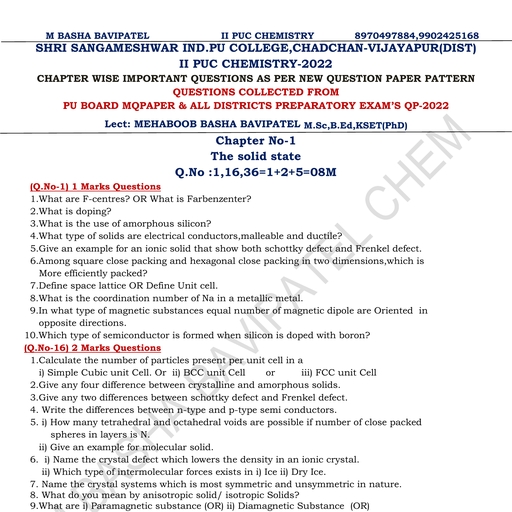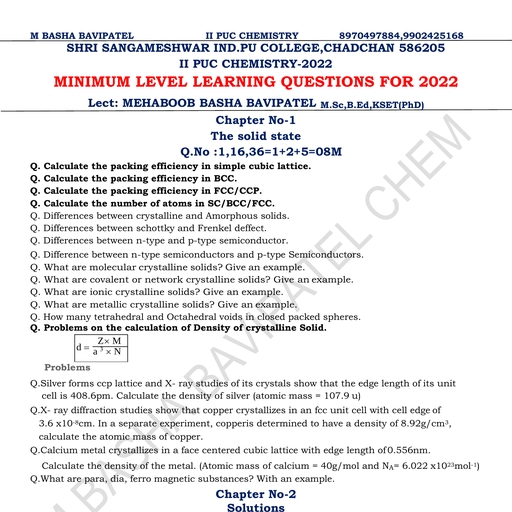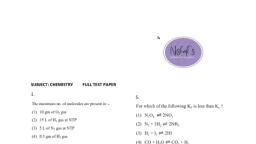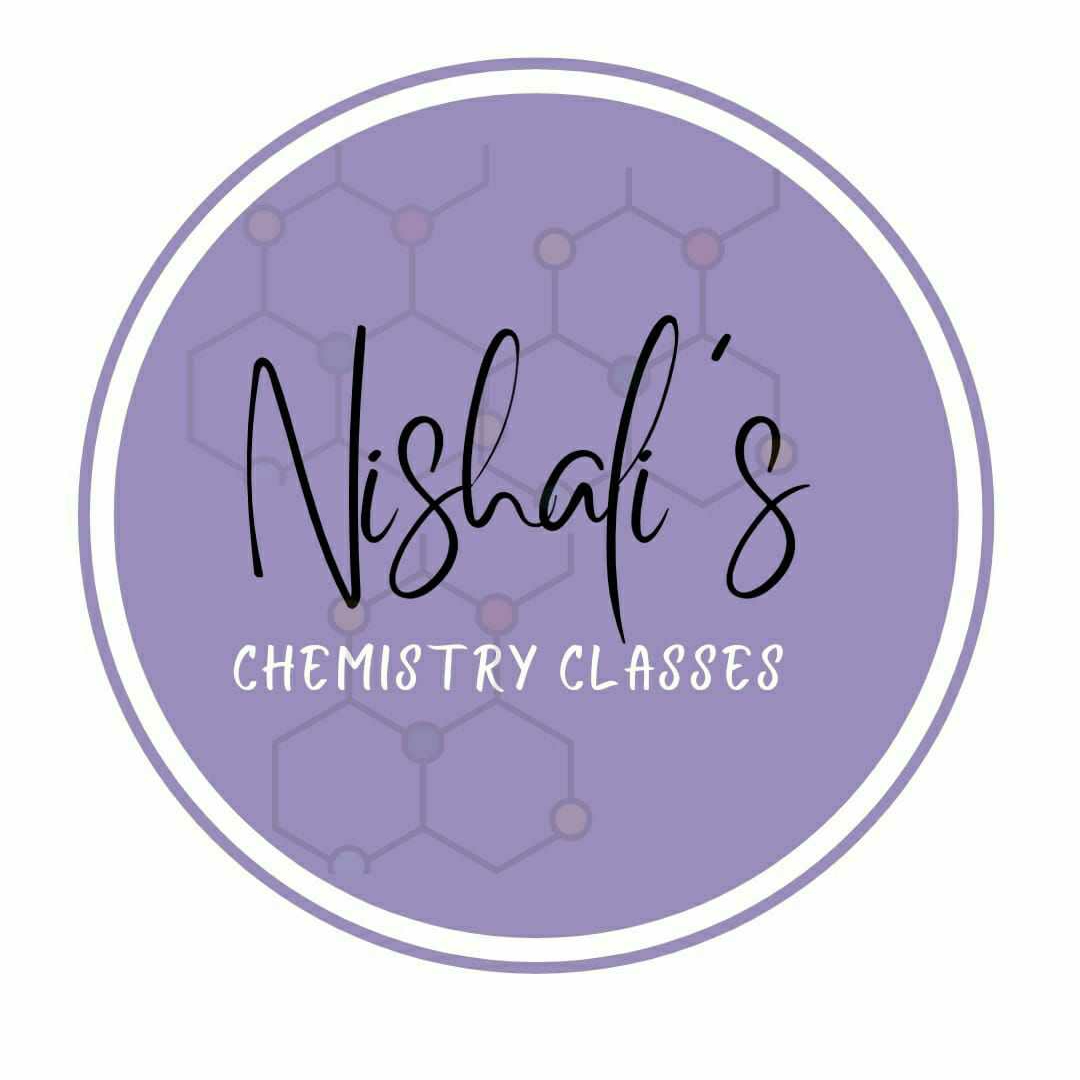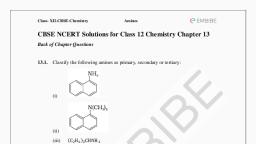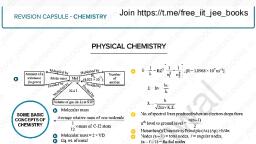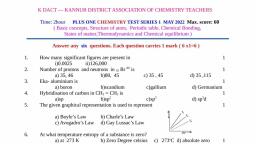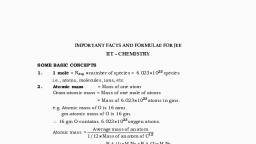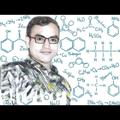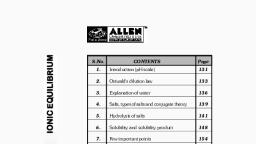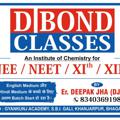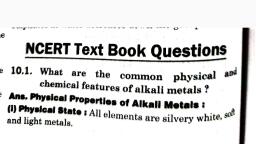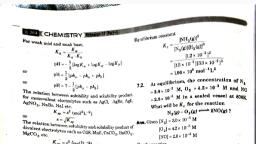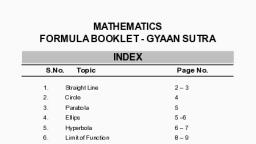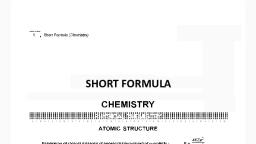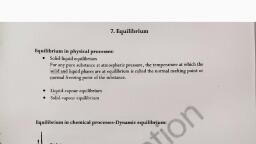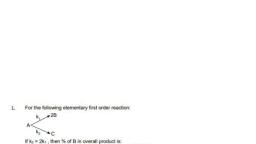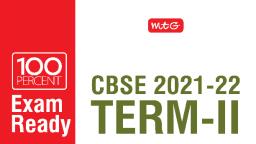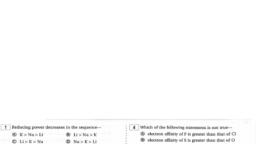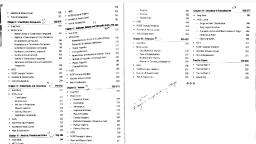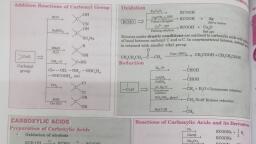Page 1 :
REVISION CAPSULE - CHEMISTRY, , Join https://t.me/free_iit_jee_books, , , , PHYSICAL CHEMISTRY, , , , , , , , , , , , , , , , , , Amount ofa] Attala by muigit +] Oo, ° substance Molar mass 6.023 © 10°) of, (in gram) —<aby Dig entities, pivides Sy 2} vided By, RS i, , , , ‘Volume of gas (in L) at STP,, , © Molccular mass, , COnGEETS Ge ws Average relative mass of one molecule e, , CHEMISTRY, , zs xmass of C-12 atom, © Molecular mass=2 VD, © £q.wt. ofmetal, , wt. of metal, =—__————_x 1.008 oe, wt. of H displaced, , , , , , wt. of metal, , =, Or Ea wtofmenl wt. of oxygen combined, , _ wt. of metal, wt. of chlorine combined, , © Molecular formula = (Empirical formula),, © Energy ofelectron in species with one oO, , 35.5, , , , , , electron., Es =2n?me*zZ?, ATOMIC ar, STRUCTURE _ For energy in SI system,, ~2n?me4Z?, Bae n7h? (469) o, 13022? f, — WN nol ‘i, n, mvr = a oO, 20, , 2,2 2, nh n, = = 0529) —] A, OO atmze [ Z }, © Total energy of electron in the n' shell, , 2 2 2 oe, =KE.+PE.= we 4| Hee __kee, 2m fy 2m, , , , CHEMICAL, BONDING, , = 1, D=— =RZ?| > -— |, [R= 1.0968 x 107m 4], My, M2, , , , No. of spectral lines produced when an electron drops from, , =I, n" Jevel to ground level = BSD., , Heisenberg's Uncertainty Principle (Ax) (Ap) >h/4n, Nodes (n— 1) = total nodes, £ = angular nodes,, (n—@—1)=Radial nodes, , Orbital angular momentum : ./¢ (€+1) = = Jee+Dh, i, © @ %ionic character, , _ _ Actual dipole moment, Calculated dipole moment, , Gi) Dipole moment is helpful in, predicting geometry and polarity, of molecule., , Fajan’s Rule : Following factors are helpful in increasing, , covalent character in ionic compounds, , (i) Small cation (ii) Big anion, , (iii) High charge on cation/anion, , (iv) Cation having pseudo inert gas configuration (ns*p°d!°), , eg. Cut, Ag*, Zn*?, Cat?, , M.O. theory :, , @ Bondorder='A(N,-N,), , Gi) Higher the bond order, higher is the bond dissociation, , energy, greater is the stability, shorter is the bond length., , Formal charge (F.C.) on an atom in a Lewis structure, , = [total number of valence electrons in the free atoms], , —[total number of non-binding (lone pair) electrons], , 1, - 7 ltotal number of bonding (shared) electrons], , Relative bond strength ; sp>d? >dsp? >sp* >sp? >sp >p-p, (Co-axial) > s - p>s-s>p-p(Co-lateral), , Scanned by CamScanner
Page 2 :
REVISION CAPSULE - CHEMISTRY, , Join https://t.me/free_iit_jee_books, , , , @_VSEPR theory, (i) (LP-LP) repulsion > (LP-BP) > (BP-BP), (ii) NH, — Bond Angle 106° 45’ because (LP-BP) repulsion, > (BP-BP) H,O —> 104° 27’because (LP-LP) repulsion >, (LP-LB)> (BP-BP), , © Hybridisation:, , ‘ number of valence electrons of central atom, =| +number of monovalent atoms attached to it, + negative charge if any — positive charge if any, , @K,=K,(RT)"" where An,_np—ny, (Free Energy Change (AG), , (a) IfAG=O then reversible reaction, would be in equilibrium, K,=0, (b) IfAG=(+) ve then equilibrium will, be displaced in backward, direction; K,<1, (c) If AG = (-) ve then equilibrium will shift in forward, direction; K,>1, © @K, unit (moles/lit)",, (b) K, unit > (atm)“", © Reaction Quotient and Equilibrium Constant, Consider the following reversible reaction, A+B=C+D, , _ [CID], Se [ANB, Case I: IfQ.,<K, then : [Reactants] > [Products], then the system is not at equilibrium, Case I: IfQ,=K, then ; The system is at equilibrium,, Case II: If Q.>K, then : [Products] > [Reactants], The system is not at equilibrium., © Arrelationship between the equilibrium constant K,, reaction, quotient and Gibb's energy., AG=AG°+RTInQ, At equilibrium AG=0 and Q=K then, AG® = -RT InK,, ’, AG°=-RTIn, © LeChatelier’s principle, @ Increase of reactant conc. (Shift reaction forward), (i) Decrease of reactant conc. (Shift reaction backward), (ii) Increase of pressure (from more moles to less moles), (iv) Decrease of pressure (from less moles to more moles), (v) For exothermic reaction decrease in temp. (Shift, forward), (vi) For endothermic increase in temp. (Shift backward), © @ LewisAcid (e pair acceptor) >, CO,, BF;, AICI;, ZnCl, normal, , CHEMICAL, , EQUILIBRIUM, , , , cation, IONIC. (ii) Lewis Base (e~ pair donor) —, EQUILIBIRIUM NH;, ROH, ROR, H,0, RNH),, normal anions, , , , © Dissociation of Weak Acid and Weak, Base, , @ Weak Acid, K, = Cx?/(1 —x) or K,=Cx?; x<<1, , (i) Weak Base, Ky, = Cx?/(1— x) or K, = Cx?;x<<1, , Buffer solution {Henderson equation} :, @ Acidic, pH=pK, + log {Salt/Acid}., For maximum buffer action pH= pK,, Range of buffer pH= pK, + |, Gi) Alkaline > pOH=pK,, + log {Salt/Base} for max. buffer, action pH= 14—pK,, Range pH= 14—pK, +1, Moles /lit of Acid or Base Mixed, Change in pH, Relation between ionisation constant (K;) and degree of, ionisation(a):K= a? 2 eC, (l-a)V (l-a), It is applicable to weak electrolytes for which a <<1 then, , K:, a= /K\V =, ea orVtCLat, Common ion effect : By addition of X mole/L ofacommon., ion, to a weak acid (or weak base) a becomes equal to, , Kw Ky ae, X (oT = J where a. = degree of dissociation], , di) Buffer Capacity =, , , , , , (Ostwald’s dilution law), , (i) If solubility product > ionic product then the solution is, unsaturated and more of the substance can be dissolved in it., (ii) Ifionic product > solubility product the solution is super, saturated (principle of precipitation)., Salt of weak acid and strong base :, , K,, pH=0.5 (pK,,+ pK, + log c); h= iKy= K, , , , c, (h = degree of hydrolysis), Salt of weak base and strong acid :, , w, , pH=0.5 (pK,,—pK, — log c); h= K,xe, Salt of weak acid and weak base :, , , , i Bias’ Ky, , pH=0.5 (pK, +pK,—pK,);h K,xK,, , © Unit of rate constant;, k= mol! Jit™ sec, Order of reaction It can be fraction,, , zero or any whole number., © Mbolecularity of reaction is always a, whole number. It is never more than three., It cannot be zero., , First Order Reactions :, , 2.303 a 0.693, k= losin @—xy & tine= |, , [A], = [Aloe, Second Order Reactions :, When concentration of A and B taking same., , laa}, at a(a—x), , When concentration of A and B are taking different 2.303 b(a-x), a= a—by 18 acb—x), , , , , , , , Scanned by CamScanner
